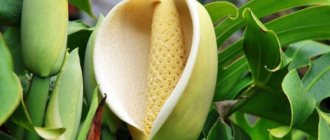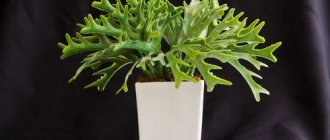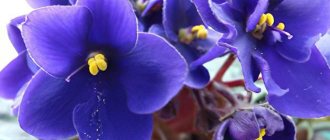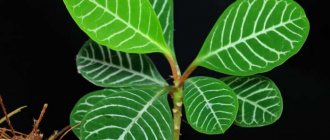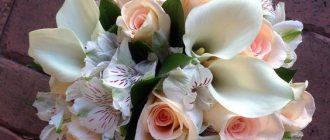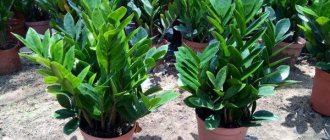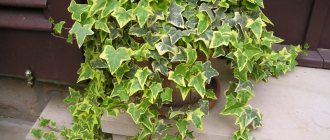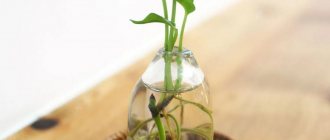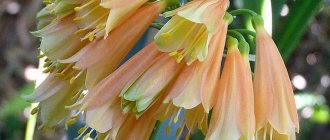Yucca is called the "palm lily". The flower belongs to the Agave family; there are about 40 species. Outwardly it resembles a small palm tree.
The distribution area of yucca is the deserts of North America; several varieties are found in the center of this continent, as well as on the islands of the Caribbean and in Asia. Prefers rocky soils and areas with plenty of sunlight. Garden plants can be up to 10 meters high and look like a tree. At home, yucca does not grow higher than 1 m.
Description
It has a thickened trunk, and therefore belongs to tree-like plants. The leaves are quite hard, sword-shaped, green with a bluish tint, and have thorns at the ends. The edges may be wavy, jagged, or hairy. The leaves are collected in a bunch at the top of the plant, are located on branched trunks, or grow from a rosette directly from the soil.
The crown includes one or more sockets. The palm flowers are white, resembling bells, up to 9 cm long. The inflorescence is an ordinary panicle.
Other colors are also found in nature: cream, yellow, canary, soft green. There are up to 200 flowers on one palm tree. Yucca rarely blooms at home. The fruit of the flower is a juicy capsule; there are also edible varieties.
The difference between yucca and dracaena
It is difficult for a novice gardener to immediately understand the difference between yucca and dracaena. The number of varieties of these indoor plants is huge; both of them are called “house palms” in everyday life, and some species are very similar in appearance. Meanwhile, it is important to know the difference and not to confuse these two flowers, so as not to ruin them, since each requires its own care.
The main difference between domestic yucca and dracaena is, first of all, that they belong to different families - Agaveaceae and Dracaenaceae, respectively. These flowers have different root systems. Dracaena has smooth roots, orange or dark yellow in cross-section, and does not form shoots like its “relative.”
The external difference is that dracaena has a thin trunk with narrow, soft and smooth leaves, while yucca has a thick trunk, and the foliage, on the contrary, is wide, with jagged edges.
Types of indoor yucca
| View | Description |
| Aloe leaf marginata | It blooms in summer, producing an inflorescence with many bell-shaped flowers. The leaves have toothed edges and the flowers are cream-colored with a purple tint. |
| Whippla | A variety of slow-growing yucca flower. The stem is shortened, the leaves are greenish with a gray tint, collected in a rosette. The edges are jagged with a spike at the tip. It blooms in summer with many bell-shaped flowers that add a light scent. The color is the same as the previous species. The price is about 4000 rubles. |
| Filamentous or Guard | Stemless, frost-resistant, grows wide. Withstands temperatures down to -20°C. The leaves are up to 65 cm long, have a green color with a bluish tint, the tip of the leaf is pointed, and there are white thread-like fibers at the ends. Blooms with yellow flowers. |
| Ivory or Elephantis | It grows slowly and eventually becomes a lush bush. The trunk is thickened, the stem is tree-like. At the top there is a rosette with stiff, light green leaves. It blooms in summer, producing a peduncle up to one meter long. |
| Gray or Candle of the Lord | Evergreen species up to 2 meters high. The leaves are collected in a large rosette, hard, bluish-green in color. There are gray fibers at the ends. Flowering occurs in summer. |
| Glorious or Joanna | A small tree, up to 5 meters long. The young plant does not have a trunk; it is a spherical shrub. It has dark green leaves with a waxy coating. It blooms in summer with white flowers with burgundy tips. As soon as the peduncle falls off, a box with black seeds forms in its place. |
Yucca can be planted together with bonsai or fuchsia. It also stands out beautifully with ficus and spathiphyllus.
Homeland of yucca
Countries where yucca grows everywhere are Central (and North) America and Mexico.
Back in the 19th century, the false palm attracted the attention of scientists so much that it became the basis of collections in many botanical gardens in all corners of the globe.
Today, the exotic tree is cultivated in greenhouses on the coast of Crimea and the Caucasus, and in the central zone, yucca has gained popularity as an unpretentious indoor plant.
The subtropical origin of yucca affects the basic rules of care and cultivation: the palm tree grows slowly, loves moist air and mild drought. Some species (filamentous, glorious, aloel-leaved) are even frost-resistant, surviving when temperatures drop to -15 degrees, and therefore are suitable for cultivation in open ground.
Home care
When growing indoor yucca, you need to pay attention to the following conditions:
| Parameter | Winter | Summer |
| Location/Lighting | Provide additional artificial lighting, since it is advisable for yucca to spend 16 hours a day under light. | Yucca will grow well on the south and southeast side of the room. Young palms will need more light than mature palms. In hot weather they should still be placed in the shade. With a lack of sun, the plant gets sick. |
| Temperature | It is advisable to provide the shrub with slight coolness up to +10°C. You can take it out onto the balcony if it is heated. Otherwise, open the window more often and place the pot closer to the glass. | Comfortable temperature up to +23°C. If it is higher, then you will need to additionally humidify the air. |
| Humidity | No need for high humidity. | When the temperature rises to +25°C, create additional humidity: spray or pour expanded clay into the pot daily and constantly moisten it. |
| Watering | Do not overwater the plant, make sure the soil dries out and reduce the frequency of watering. | Watering should be frequent, but excess water from the pan must be drained in a timely manner, otherwise the roots will rot. |
| Top dressing | No fertilizer needed. | Feed with mineral fertilizers once a week. Suitable compositions for cacti and palm trees. |
Trimming
It promotes the growth of new shoots, from which beautiful and lush bushes are formed. Formation is carried out in March, the upper part is cut off with pruning shears, departing 60 cm from the rosette. You cannot break the trunk, this will lead to a protracted disease of the bush or its death, you need to carefully and sharply cut the stem.
A fresh cut should be sprinkled with charcoal or filled with paraffin, so the yucca will retain moisture inside. After placing the bush in a dark place, after 3 months new shoots will appear at the cut site.
Only plants with a trunk diameter greater than 5 centimeters can be cut. Otherwise, the stem cannot be trimmed.
Choosing a pot, soil, replanting
The first transplant should be carried out immediately after purchasing the plant, and the next one in March. While the shrub is young, it can be replanted annually, after which once every 3 years.
It is advisable to plant directly with a clod of earth on the roots. Be sure to add drainage to the bottom of the pot so that the roots do not rot after watering.
Step-by-step transplant:
- Buy a clay pot with holes in the bottom for drainage, 2 sizes larger than the previous one.
- Pour drainage 4 cm high at the bottom, and sprinkle earth on top.
- With a lump of earth on the roots, transfer the plant to a new pot.
- Fill the remaining empty spaces with soil and compact them gently.
You need to remove black, dry roots in advance, and sprinkle the sections with activated carbon. After transplantation, the yucca does not grow for one and a half months.
Slightly acidic soil is suitable for the plant. It should conduct water and nutrients well to the roots. It is better to add river sand or humus to the soil mixture. There are ready-made compositions for palm trees, cacti and dracaenas in which yucca can be planted.
Diseases
Knowing how to care for yucca in a pot at home, you can prevent many plant ailments.
The first indicator showing that something is wrong with a flower is its leaves. The slightest changes in color or appearance will help identify the disease and eliminate its cause.
Rot
Stem rot occurs due to overcooling of the soil or excessive watering. Water stagnating in the pot causes the development of fungi, which, by multiplying, shorten the life of the plant.
A softened stem, pale and drooping leaves indicate that the disease is progressing. Yucca can be saved if a small part of it is affected. In this case, you need to remove rotten tissue from the flower. If most of the plant is affected, it must be disposed of, thus protecting other flowers in the neighborhood from further infection.
Carefully monitor the condition of the soil before watering. The lower the temperature in the place where the pot is located, the less frequent irrigation the plant needs. When giving your yucca a warm shower, make sure that the water does not drain into the ground.
Tip : when replanting a flower, add coarse river sand, expanded clay and other loosening additives to the soil.
Dry spots on leaves
The main reason for the appearance of light and dry spots on yucca foliage is sunburn. The problem is solved by curtaining the window near which the pot stands, or by moving the flower to another place. It would be ideal to locate the plant in the southeast or southwest side of the apartment near sources of natural light.
If the leaves lose color, turn yellow and dry out at the base, and at the same time the yucca “stretches” strongly upward, the reason, on the contrary, is a lack of lighting. This often happens in winter, and also if the pot is located in the back of the room, where there is not enough light. Follow the rules for placing the flower to avoid it wilting.
Leaf spot
The reason yucca leaves are covered with brown spots lies in excessive soil moisture, which causes fungus to appear in the root part of the flower. After immediately removing the affected areas, treat the plant with a fungicide such as “Fitosporin”, stop watering for a while and move the flower to a more illuminated place.
Brown spots can also appear on leaves due to unsuitable soil. Too alkaline or acidic soil affects the healthy development of the flower.
To avoid root hypoxia and further wilting of the foliage, mix sufficient drainage into the soil.
Foliage curls
As a rule, yucca leaves curl due to excessive watering or lack of it. Another reason is temperature changes. Be careful when irrigating the flower; the water should not be too cold. It is advisable to keep yucca away from windows in winter and also protect it from drafts.
In its homeland, yucca is considered the “tree of happiness.” Such a plant, when in the house, will cleanse its aura and charge it with positive energy, give its owners peace, and create an atmosphere of peace and comfort. If you care for a flower correctly and with love, it will decorate your home or office for many years with its spectacular and exotic appearance.
Reproduction
Gardeners propagate yucca in four ways.
Seeds
The main thing here is to choose the right seeds for planting. You can collect them at home only after pollination. Stages:
- File the seeds with sandpaper so that the hard shell is damaged, so they will sprout faster.
- Soak them in water for a day.
- Plant in a small container with a special earthen mixture.
- Cover with film and place in a warm place in the house with good lighting, constantly moisten the soil.
- Wipe the film every day to remove condensation.
- As soon as shoots and leaves appear (in about a month), plant the plants in different containers and feed them with fertilizers on the 10th day.
- After the germination of 5 leaves, the plant is considered mature.
Cuttings
- Make a smooth cut from an adult plant.
- Dry and treat with growth agent.
- For soil, use a mixture of peat and river sand.
- Transfer the cutting to the ground and bury it 3-4 cm in the soil.
- Water the soil well and spray the shoot itself daily.
Parts of the trunk
This way you can propagate an adult plant, but only in the spring. Process:
- Carefully cut off the top of the bush and dry.
- Place the cuttings in water until they form the first roots, then into the soil.
- As soon as the buds produce young shoots, plant them.
Adventitious roots
Used for stemless yucca species. In summer or spring, the root shoots are cut off with a knife, and the seedlings are transplanted into a pot with wet sand.
Errors in care
| Symptom | Error | Elimination |
| The trunk softens and brown spots appear. | The soil is excessively moist. | Maintain regular watering. |
| Dry and light spots form. | Excess light | Maintain temperature conditions. |
| Leaves curl and brown spots appear. | Insufficient humidity and watering. | Scheduled watering and daily spraying. |
| The leaves turn pale and thin. | Poor lighting and high temperatures. | Observe light and temperature conditions. |
Diseases, pests
| Symptom (what happens to the leaves) | Disease/Pest | Treatment |
| Drying. |
| Regular watering, spraying the plant and humidifying the air in the room. |
| They turn yellow. | This is a natural process. The leaves live for a couple of years, then turn yellow and die. | No treatment required. |
| They fall off. |
| Observe the watering schedule, provide heat and close the windows. |
| Light spots form on them. | Too much light. | Observe the light regime. |
| Rolled into a tube. | The reason is hypothermia. | Adjust the room temperature. |
| Dark spots appear on them. |
| Remove affected leaves and spray the plant with fungicide. Reduce watering. |
| They turn pale and stretch out. |
| Observe heat and light conditions. |
| Pests are visible on them: mites, aphids and caterpillars. | Excessive watering. | Spray with insecticides. |
Possible problems, diseases and pests
Problems that may arise when growing Yucca:
| Problem | Cause |
| The ends of the leaves darken | Excessive or too frequent watering |
| The lower leaves turn yellow | This is a natural process |
| The leaves are falling | This is a normal state for Yucca after transplantation or purchase. In other cases, leaf shedding may be the result of hypothermia |
| The tips and edges of the leaves dry out and turn brown | Too dry air, draft, improper watering |
| Brown spots on leaves | Drying of the earthen coma |
| The leaves are curling | Low air temperature |
| Dry light spots on foliage | Result of exposure to direct sunlight |
| Among the pests that pose a danger to the plant are whiteflies, spider mites, scale insects, mealybugs, aphids and thrips. To combat them, insecticides are used: “Akarin”, “Aktellik”, “Arrivo”, “Apache”, “Bazudin”, Bona Forte, “Decis”, “Green Soap”, “Iskra”, “Confidor”, “Karate” | |
| Yucca can be affected by stem and root rot, bacteriosis, gray and brown spots, and fire blight. In these cases, the damaged parts are removed, and the plant is treated with fungicides: “Consento”, “Agat”, “Abiga-Pik”, “Albit”, “Baktofit”, “Vitaros”, “Vectra”, “Quadris”, “Maxim”, “Profit Gold”, “Strobe”, “Thanos”, “Fundazol”, “Fitolavin”, “Chorus”, “Hom” | |
